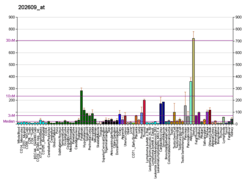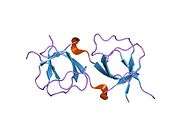EPS8
Epidermal growth factor receptor kinase substrate 8 is an enzyme that in humans is encoded by the EPS8 gene.[5][6]
Function
This gene encodes a member of the EPS8 family. This protein contains one PH domain and one SH3 domain. It functions as part of the EGFR pathway, though its exact role has not been determined. Highly similar proteins in other organisms are involved in the transduction of signals from Ras to Rac and growth factor-mediated actin remodeling. Alternate transcriptional splice variants of this gene have been observed but have not been thoroughly characterized.[6]
Clinical significance
Mutations in EPS8 cause congenital deafness.Behlouli A, Bonnet C, Abdi S, Bouaita A, Lelli A, Hardelin JP, Schietroma C, Rous Y, Louha M, Cheknane A, Lebdi H, Boudjelida K, Makrelouf M, Zenati A, Petit C (2014). "EPS8, encoding an actin-binding protein of cochlear hair cell stereocilia, is a new causal gene for autosomal recessive profound deafness". Orphanet Journal of Rare Diseases. 9 (1): 55. doi:10.1186/1750-1172-9-55. PMC 4022326. PMID 24741995.
Interactions
EPS8 has been shown to interact with:
References
- GRCh38: Ensembl release 89: ENSG00000151491 - Ensembl, May 2017
- GRCm38: Ensembl release 89: ENSMUSG00000015766 - Ensembl, May 2017
- "Human PubMed Reference:". National Center for Biotechnology Information, U.S. National Library of Medicine.
- "Mouse PubMed Reference:". National Center for Biotechnology Information, U.S. National Library of Medicine.
- Wong WT, Carlomagno F, Druck T, Barletta C, Croce CM, Huebner K, Kraus MH, Di Fiore PP (October 1994). "Evolutionary conservation of the EPS8 gene and its mapping to human chromosome 12q23-q24". Oncogene. 9 (10): 3057–61. PMID 8084614.
- "Entrez Gene: EPS8 epidermal growth factor receptor pathway substrate 8".
- Offenhäuser N, Borgonovo A, Disanza A, Romano P, Ponzanelli I, Iannolo G, Di Fiore PP, Scita G (January 2004). "The eps8 family of proteins links growth factor stimulation to actin reorganization generating functional redundancy in the Ras/Rac pathway". Mol. Biol. Cell. 15 (1): 91–8. doi:10.1091/mbc.E03-06-0427. PMC 307530. PMID 14565974.
- Biesova Z, Piccoli C, Wong WT (January 1997). "Isolation and characterization of e3B1, an eps8 binding protein that regulates cell growth". Oncogene. 14 (2): 233–41. doi:10.1038/sj.onc.1200822. PMID 9010225.
- Lanzetti L, Rybin V, Malabarba MG, Christoforidis S, Scita G, Zerial M, Di Fiore PP (November 2000). "The Eps8 protein coordinates EGF receptor signalling through Rac and trafficking through Rab5". Nature. 408 (6810): 374–7. Bibcode:2000Natur.408..374L. doi:10.1038/35042605. PMID 11099046.
- Rual JF, Venkatesan K, Hao T, Hirozane-Kishikawa T, Dricot A, Li N, Berriz GF, Gibbons FD, Dreze M, Ayivi-Guedehoussou N, Klitgord N, Simon C, Boxem M, Milstein S, Rosenberg J, Goldberg DS, Zhang LV, Wong SL, Franklin G, Li S, Albala JS, Lim J, Fraughton C, Llamosas E, Cevik S, Bex C, Lamesch P, Sikorski RS, Vandenhaute J, Zoghbi HY, Smolyar A, Bosak S, Sequerra R, Doucette-Stamm L, Cusick ME, Hill DE, Roth FP, Vidal M (October 2005). "Towards a proteome-scale map of the human protein-protein interaction network". Nature. 437 (7062): 1173–8. Bibcode:2005Natur.437.1173R. doi:10.1038/nature04209. PMID 16189514.
- Funato Y, Terabayashi T, Suenaga N, Seiki M, Takenawa T, Miki H (August 2004). "IRSp53/Eps8 complex is important for positive regulation of Rac and cancer cell motility/invasiveness". Cancer Res. 64 (15): 5237–44. doi:10.1158/0008-5472.CAN-04-0327. PMID 15289329.
- Inobe M, Katsube Ki, Miyagoe Y, Nabeshima Yi, Takeda S (December 1999). "Identification of EPS8 as a Dvl1-associated molecule". Biochem. Biophys. Res. Commun. 266 (1): 216–21. doi:10.1006/bbrc.1999.1782. PMID 10581192.
- Karlsson T, Songyang Z, Landgren E, Lavergne C, Di Fiore PP, Anafi M, Pawson T, Cantley LC, Claesson-Welsh L, Welsh M (April 1995). "Molecular interactions of the Src homology 2 domain protein Shb with phosphotyrosine residues, tyrosine kinase receptors and Src homology 3 domain proteins". Oncogene. 10 (8): 1475–83. PMID 7537362.
- Matoskova B, Wong WT, Salcini AE, Pelicci PG, Di Fiore PP (July 1995). "Constitutive phosphorylation of eps8 in tumor cell lines: relevance to malignant transformation". Mol. Cell. Biol. 15 (7): 3805–12. doi:10.1128/mcb.15.7.3805. PMC 230619. PMID 7791787.
- Scita G, Nordstrom J, Carbone R, Tenca P, Giardina G, Gutkind S, Bjarnegård M, Betsholtz C, Di Fiore PP (September 1999). "EPS8 and E3B1 transduce signals from Ras to Rac". Nature. 401 (6750): 290–3. Bibcode:1999Natur.401..290S. doi:10.1038/45822. PMID 10499589.
- Maa MC, Lai JR, Lin RW, Leu TH (July 1999). "Enhancement of tyrosyl phosphorylation and protein expression of eps8 by v-Src". Biochim. Biophys. Acta. 1450 (3): 341–51. doi:10.1016/s0167-4889(99)00069-5. PMID 10395945.
Further reading
- Di Fiore PP, Scita G (2002). "Eps8 in the midst of GTPases". Int. J. Biochem. Cell Biol. 34 (10): 1178–83. doi:10.1016/S1357-2725(02)00064-X. PMID 12127568.
- Cardwell C (1977). "Student or worker? International Meeting of Student Nurses (European Group)". Nursing Mirror and Midwives Journal. 143 (19): 38. PMID 1049958.
- Castagnino P, Biesova Z, Wong WT, Fazioli F, Gill GN, Di Fiore PP (1995). "Direct binding of eps8 to the juxtamembrane domain of EGFR is phosphotyrosine- and SH2-independent". Oncogene. 10 (4): 723–9. PMID 7532293.
- Karlsson T, Songyang Z, Landgren E, Lavergne C, Di Fiore PP, Anafi M, Pawson T, Cantley LC, Claesson-Welsh L, Welsh M (1995). "Molecular interactions of the Src homology 2 domain protein Shb with phosphotyrosine residues, tyrosine kinase receptors and Src homology 3 domain proteins". Oncogene. 10 (8): 1475–83. PMID 7537362.
- Avantaggiato V, Torino A, Wong WT, Di Fiore PP, Simeone A (1995). "Expression of the receptor tyrosine kinase substrate genes eps8 and eps15 during mouse development". Oncogene. 11 (6): 1191–8. PMID 7566980.
- Matoskova B, Wong WT, Salcini AE, Pelicci PG, Di Fiore PP (1995). "Constitutive phosphorylation of eps8 in tumor cell lines: relevance to malignant transformation". Mol. Cell. Biol. 15 (7): 3805–12. doi:10.1128/MCB.15.7.3805. PMC 230619. PMID 7791787.
- Fazioli F, Minichiello L, Matoska V, Castagnino P, Miki T, Wong WT, Di Fiore PP (1993). "Eps8, a substrate for the epidermal growth factor receptor kinase, enhances EGF-dependent mitogenic signals". EMBO J. 12 (10): 3799–808. doi:10.1002/j.1460-2075.1993.tb06058.x. PMC 413663. PMID 8404850.
- Matòsková B, Wong WT, Seki N, Nagase T, Nomura N, Robbins KC, Di Fiore PP (1996). "RN-tre identifies a family of tre-related proteins displaying a novel potential protein binding domain". Oncogene. 12 (12): 2563–71. PMID 8700515.
- Matòsková B, Wong WT, Nomura N, Robbins KC, Di Fiore PP (1996). "RN-tre specifically binds to the SH3 domain of eps8 with high affinity and confers growth advantage to NIH3T3 upon carboxy-terminal truncation". Oncogene. 12 (12): 2679–88. PMID 8700527.
- Biesova Z, Piccoli C, Wong WT (1997). "Isolation and characterization of e3B1, an eps8 binding protein that regulates cell growth". Oncogene. 14 (2): 233–41. doi:10.1038/sj.onc.1200822. PMID 9010225.
- Kishan KV, Scita G, Wong WT, Di Fiore PP, Newcomer ME (1997). "The SH3 domain of Eps8 exists as a novel intertwined dimer". Nat. Struct. Biol. 4 (9): 739–43. doi:10.1038/nsb0997-739. PMID 9303002.
- Maa MC, Lai JR, Lin RW, Leu TH (1999). "Enhancement of tyrosyl phosphorylation and protein expression of eps8 by v-Src". Biochim. Biophys. Acta. 1450 (3): 341–51. doi:10.1016/S0167-4889(99)00069-5. PMID 10395945.
- Scita G, Nordstrom J, Carbone R, Tenca P, Giardina G, Gutkind S, Bjarnegård M, Betsholtz C, Di Fiore PP (1999). "EPS8 and E3B1 transduce signals from Ras to Rac". Nature. 401 (6750): 290–3. Bibcode:1999Natur.401..290S. doi:10.1038/45822. PMID 10499589.
- Lanzetti L, Rybin V, Malabarba MG, Christoforidis S, Scita G, Zerial M, Di Fiore PP (2000). "The Eps8 protein coordinates EGF receptor signalling through Rac and trafficking through Rab5". Nature. 408 (6810): 374–7. Bibcode:2000Natur.408..374L. doi:10.1038/35042605. PMID 11099046.
- Ion A, Crosby AH, Kremer H, Kenmochi N, Van Reen M, Fenske C, Van Der Burgt I, Brunner HG, Montgomery K, Kucherlapati RS, Patton MA, Page C, Mariman E, Jeffery S (2000). "Detailed mapping, mutation analysis, and intragenic polymorphism identification in candidate Noonan syndrome genes MYL2, DCN, EPS8, and RPL6". J. Med. Genet. 37 (11): 884–6. doi:10.1136/jmg.37.11.884. PMC 1734479. PMID 11185075.
- Scita G, Tenca P, Areces LB, Tocchetti A, Frittoli E, Giardina G, Ponzanelli I, Sini P, Innocenti M, Di Fiore PP (2001). "An effector region in Eps8 is responsible for the activation of the Rac-specific GEF activity of Sos-1 and for the proper localization of the Rac-based actin–polymerizing machine" (PDF). J. Cell Biol. 154 (5): 1031–44. doi:10.1083/jcb.200103146. PMC 2196181. PMID 11524436.








